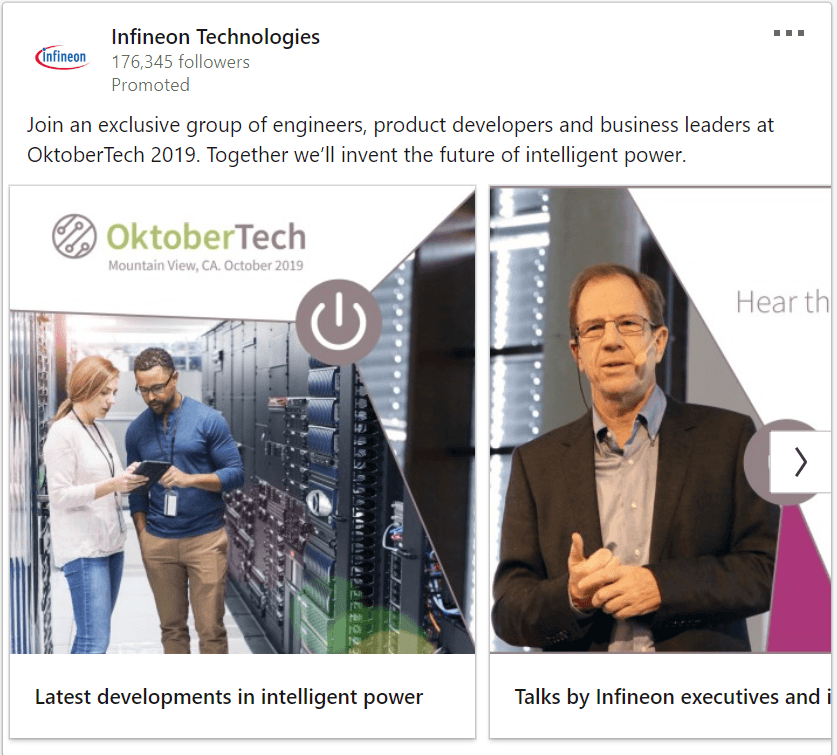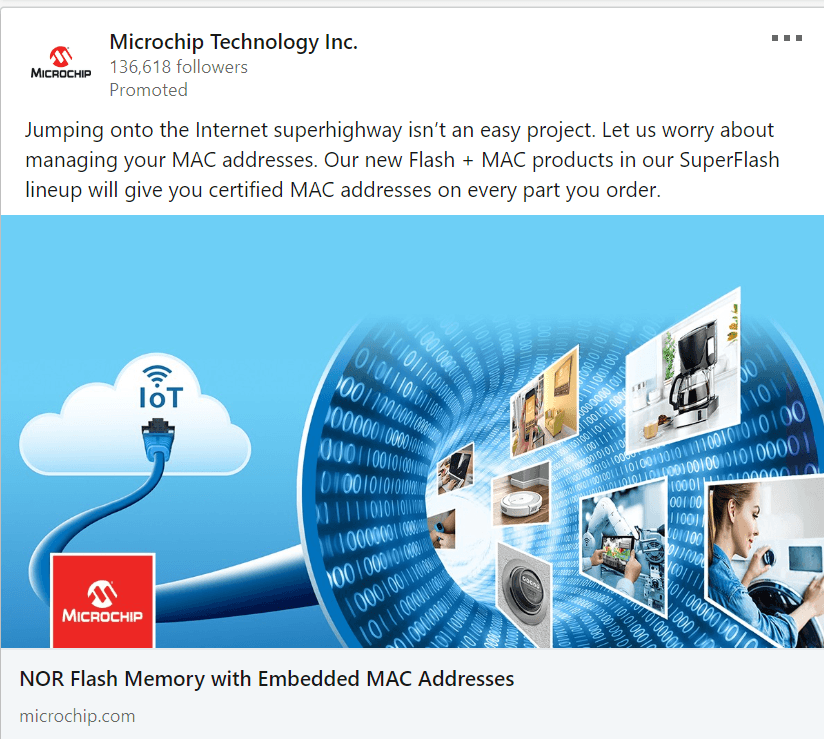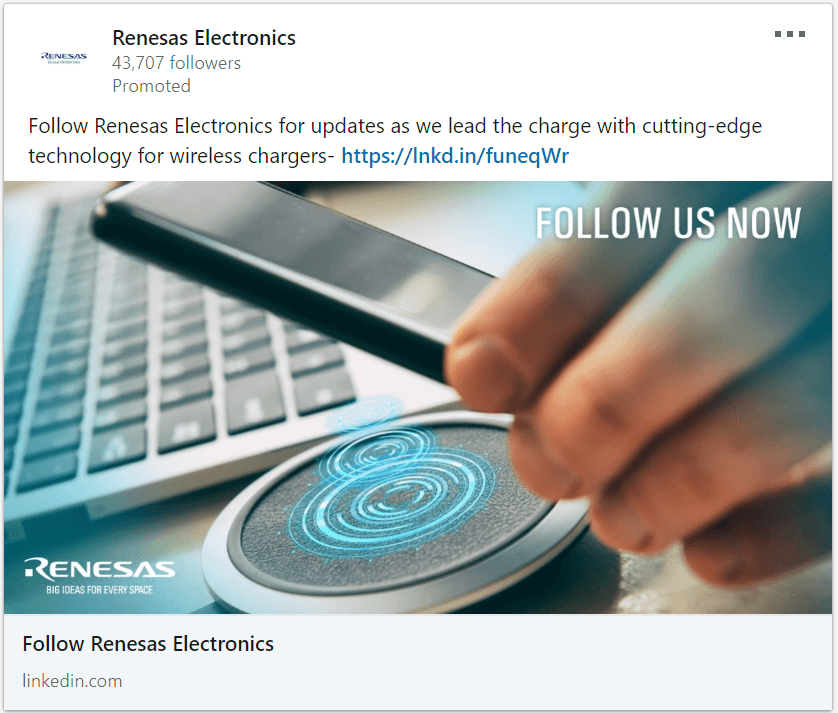It’s interesting that there is still a divide over whether social media is an effective channel for semiconductor companies. Ultimately, the only way companies can really know is to try the platforms and see whether they generate ROI that matches other channels, although our experience is that they probably will: LinkedIn seems to be generating great results.
Rather than listen to an agency’s view, as we’re probably not completely impartial, I thought it would be interesting to look at which of the top Microcontroller vendors are using paid social media, in particular Facebook and LinkedIn. Both platforms allow anyone to view the adverts being run by an organisation, although you can’t see who is targeted by the adverts and how much is being spent (Facebook does show more information for political ads than commercial ones).
For the purposes of this rather informal (but hopefully informative!) study, I picked the following seven vendors:
- Cypress
- Infineon Technologies
- Microchip Technology
- NXP
- Renesas
- Silicon Labs
- Texas Instruments
LinkedIn Advertising: Everyone is Doing it!
When you visit a company’s LinkedIn page, you’re able to view the ads that it is running. For this blog post, we just looked at the company’s main page (so IDT, which has its own page but is part of Renesas, for example, was not included).
Perhaps unsurprisingly, all seven vendors are running adverts on LinkedIn. This is a clear reflection of the effectiveness and ability to target on the LinkedIn platform, and the results that can be generated. The tactics used, however, differed from one company to another.
Infineon is running a lot of corporate/image advertising on LinkedIn. Although they are running a few product adverts (e.g. for their gesture control device used on the Pixel 4 smartphone), most contain high-level messages such as:
Infineon is also promoting their upcoming event in the USA, OktoberTech:
The ability to target by location makes LinkedIn a great tool for promoting events, and Silicon Labs is also running event advertising, this time promoting a seminar about their products being run by Arrow. Silicon Labs are running slightly different adverts for each location:
Microchip, NXP, Silicon Labs and TI all had similar approaches, primarily promoting products or solutions for particular applications. TI has a significant percentage of video adverts, while Microchip and NXP tended to use eye-catching static images:
Unlike the other companies, Renesas seems focussed on acquiring followers on LinkedIn. While the others routed clicks directly to relevant pages, Renesas prefers sending clicks to their company page on LinkedIn, encouraging people to follow them:
We did notice that some of our group were running AB tests. Although it’s not always possible to detect whether two similar adverts are being run to AB test them, or for other reasons, we’d be pretty sure that NXP is testing the different copy on these two adverts:
Silicon Labs is another believer in testing creative, running several versions of their advert for the Wireless Gecko Series 2, including:
Although it’s great to see companies getting data on what works and what doesn’t, we did notice that this group only tended to test the text and not changes to the image. Although it’s obviously much more difficult to create variations of images, we’d hope that this is something that they will be doing soon.
Cypress is probably the least active of the group, with LinkedIn showing only one advert that promotes the CEO’s latest blog post:
Facebook: Still Not Sure It’s Right
The most interesting finding was that Cypress, Infineon, Microchip, NXP and Silicon Labs are not running paid campaigns on Facebook. It’s not possible to know whether these companies have tried Facebook and found it didn’t work, or simply have not tried campaigns, but it’s clear that when it comes to social media the microcontroller industry is all-in on LinkedIn and unsure about Facebook.
Renesas and Texas Instruments are running campaigns, with Renesas running five different ads, and TI having created 22 different ads during October alone. We would guess that Renesas has only just started running Facebook ads, but can’t be completely sure about this, whereas TI has a significant history of adverts on the platform.
Both companies are running similar adverts to their LinkedIn campaigns. For example (LinkedIn ad on the left, Facebook on the right):
Renesas are running a couple of versions of their wireless charging creative, which routes to the Renesas Facebook page in a bid to grow followers (clearly they didn’t get the message about company pages being de-emphasised in the Facebook feed), as well as two adverts for IDT products that route to relevant pages about the product and a joint promotion with a partner that routes to the partner’s website.
TI is running some advertising in Korean, although these route through to English language pages:
Paid Social: Conclusions
We thought it would be fun to look at activities on paid social media for a blog post, and as well as enjoying the research we found it extremely informative. We think that it’s reasonable to draw the following conclusions:
- Electronics component companies should be running paid LinkedIn campaigns: 100% of our sample can’t be wrong (we hope)!
- The jury is still out on Facebook, but TI seems particularly committed to using it as an advertising platform. Perhaps it’s time for others to try it?
- If we look at the companies who seem most active, and assume they are getting the best results, it’s clear that you should be AB testing the adverts you run. You might get a competitive advantage if you AB test the images you use as this isn’t something that’s happening at a significant level
- Events are worth promoting on LinkedIn
Sadly there is no way of us knowing anything about the effectiveness of the adverts being run: we would love to know how Infineon is measuring the corporate/image campaign and if they feel it’s working; it would be fascinating to compare the different creatives to find out what drives the most clicks (is video worth the extra money, for example?) and I’d love to see the results of the AB tests being run. I suspect that the companies we’ve looked at will choose to keep their results confidential, but if anyone reading this is feeling brave, please contact me.
Author
-
In 2001 Mike acquired Napier with Suzy Kenyon. Since that time he has directed major PR and marketing programmes for a wide range of technology clients. He is actively involved in developing the PR and marketing industries, and is Chair of the PRCA B2B Group, and lectures in PR at Southampton Solent University. Mike offers a unique blend of technical and marketing expertise, and was awarded a Masters Degree in Electronic and Electrical Engineering from the University of Surrey and an MBA from Kingston University.
View all posts














That’s really nice analyze! We are also trying to understand which is the best option regarding the social sites.
Facebook doesn’t sound bad if you are able to build during the time a real community based on as many as possible followers and to insert in your web page their “Facebook pixel” code. But if you are trying to get more followers, based on paid campaigns only, sometimes you can get weird messages and comments 🙂
Yeah doing AB testing can give better results for facebook Ads. Can you explain about twitter posts promotions for website blogs and other things as explained for facebook?
Great Blog !!